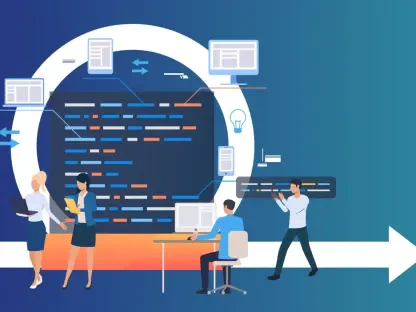In an era where cyber threats evolve at an unprecedented pace, enterprises face a staggering reality: the global cost of cybercrime is projected to reach $10.5 trillion annually by the end of this year, underscoring the critical need for robust cybersecurity solutions. As organizations navigate increasingly complex digital landscapes, hybrid environments, sprawling cloud infrastructures, and the rapid adoption of artificial intelligence (AI) have reshaped the battleground, demanding innovative approaches to protect mission-critical systems. This report delves into the strategic partnership between IBM and Trend Micro, exploring how their collaboration is pioneering AI-driven cybersecurity to address these pressing challenges and redefine enterprise security.
The Landscape of Enterprise Cybersecurity Today
Enterprise cybersecurity has become a cornerstone of organizational resilience amid digital transformation. As companies adopt hybrid environments that blend on-premises systems with cloud platforms, the attack surface expands across mainframes, endpoints, and AI workflows. This complexity is compounded by the need to secure diverse assets while maintaining operational efficiency, making cybersecurity a top priority for businesses of all sizes. Major players like IBM and Trend Micro are at the forefront, delivering solutions that tackle these multifaceted challenges with cutting-edge technology.
Technological advancements, particularly in AI and predictive analytics, are revolutionizing security practices. These tools enable real-time threat detection and proactive risk mitigation, shifting the paradigm from reactive measures to strategic defense. Beyond technology, compliance with regulatory frameworks is paramount in an interconnected digital ecosystem. Standards governing data protection and AI usage are tightening, requiring organizations to integrate continuous monitoring and governance into their security strategies to avoid costly penalties and reputational damage.
AI-Driven Innovations in Cybersecurity
Emerging Trends and Technologies
AI has emerged as a double-edged sword in enterprise security, serving as both a powerful defensive tool and a potential target for cybercriminals. Leveraging machine learning algorithms, companies can now detect anomalies in transactional data and user behavior with unprecedented accuracy. Predictive analytics and real-time telemetry further enhance this capability, allowing security teams to anticipate threats before they materialize, while integrated risk management unifies these efforts under a single framework for streamlined operations.
A notable trend is the move toward unified visibility across diverse assets, from mainframes to cloud containers. This holistic approach ensures that no component is left vulnerable, enabling proactive threat mitigation through actionable insights. Additionally, the industry is witnessing a rise in collaborative ecosystems, where partnerships between technology leaders foster innovation and create comprehensive security solutions tailored to complex environments.
Market Impact and Growth Projections
The adoption of AI-driven cybersecurity solutions is already yielding measurable benefits, with studies from the Enterprise Strategy Group showing average savings of $1.3 million due to a 99.6% reduction in alert volumes and 65% faster response times. These efficiencies highlight the transformative potential of AI in reducing operational burdens and enhancing threat response capabilities. As more organizations recognize these advantages, the market for AI-integrated security platforms is experiencing rapid growth.
Looking ahead, forecasts indicate significant expansion in this sector over the next few years, with projections estimating robust demand for services that combine AI with real-time risk assessment from 2025 to 2027. This growth trajectory suggests that AI-driven innovations will fundamentally reshape enterprise risk management, prioritizing predictive capabilities over traditional, reactive approaches and setting a new standard for security effectiveness.
Challenges in Modern Cybersecurity
Securing hybrid environments presents a formidable challenge as organizations balance the integration of AI with application modernization. The diversity of infrastructure components—from legacy mainframes to modern cloud systems—creates gaps that cybercriminals can exploit. Moreover, the rapid pace of digital transformation often outstrips the ability to implement consistent security measures across all platforms, amplifying vulnerabilities.
AI itself introduces unique complexities, functioning as both a protective mechanism and a potential point of failure. Attackers increasingly target AI models to manipulate outcomes or extract sensitive data, necessitating robust safeguards. Scalability and adaptability also pose market-driven hurdles, as solutions must evolve to meet the dynamic needs of enterprises without compromising performance or cost-effectiveness.
To address these obstacles, automation plays a pivotal role by reducing manual workloads and enhancing response times. Strategic partnerships, such as those between technology giants, further bolster capabilities by combining expertise and resources. These collaborative efforts are essential for developing resilient frameworks that can withstand the evolving threat landscape.
Regulatory and Compliance Frameworks
The regulatory landscape for cybersecurity is in constant flux, with new guidelines emerging to govern AI usage and data protection. Industry standards are becoming more stringent, requiring organizations to adopt comprehensive governance models that ensure accountability and transparency. This evolution is particularly critical for sectors handling sensitive information, where non-compliance can result in severe consequences.
IBM and Trend Micro are actively contributing to standards bodies, aligning their solutions with global compliance requirements. Their efforts focus on embedding regulatory considerations into security practices, especially for AI development workflows and large language models. By prioritizing adherence to these frameworks, both companies help enterprises navigate the complexities of legal obligations while maintaining robust defenses.
Continuous compliance monitoring is now a vital component of enterprise risk scoring, ensuring that organizations remain aligned with evolving mandates. This integration allows for real-time assessment of regulatory adherence, providing a clear picture of risk exposure. As regulations tighten, such proactive measures are indispensable for safeguarding both data and reputation in a highly scrutinized digital environment.
Future Directions for AI-Driven Security
Emerging technologies like quantum-safe infrastructure are poised to redefine cybersecurity in the coming years. These advancements promise to protect against future threats that could exploit vulnerabilities in current encryption methods, ensuring long-term data security. Alongside this, advanced predictive analytics will continue to refine threat anticipation, enabling organizations to stay ahead of sophisticated attacks.
Market disruptors, such as increasingly complex cyber threats targeting AI systems, are expected to challenge existing paradigms. Adversaries are likely to develop tactics that manipulate or bypass AI defenses, necessitating constant innovation in security protocols. This dynamic underscores the importance of agility in adapting to unforeseen risks while maintaining operational continuity.
Consumer and organizational preferences are also shifting toward sustainable, high-performance security solutions. There is growing demand for systems that minimize environmental impact through energy-efficient designs without sacrificing effectiveness. Global partnerships and economic conditions will further influence these trends, shaping long-term growth areas through collaborative innovation and strategic investments.
Conclusion and Strategic Outlook
Reflecting on the insights gathered, the partnership between IBM and Trend Micro marks a significant milestone in addressing the intricate challenges of modern cybersecurity. Their combined expertise in AI-driven solutions offers a transformative approach that balances innovation with compliance and sustainability. This collaboration sets a precedent for how strategic alliances can tackle the complexities of hybrid environments and digital threats.
Looking ahead, organizations are encouraged to explore practical engagements with such solutions through industry events and trial programs like Trend Vision One. Investing in scalable, predictive security platforms emerges as a critical step for staying resilient against evolving risks. Furthermore, fostering a culture of continuous learning and adaptation is deemed essential to anticipate market shifts and regulatory changes, ensuring sustained protection in an ever-changing landscape.









